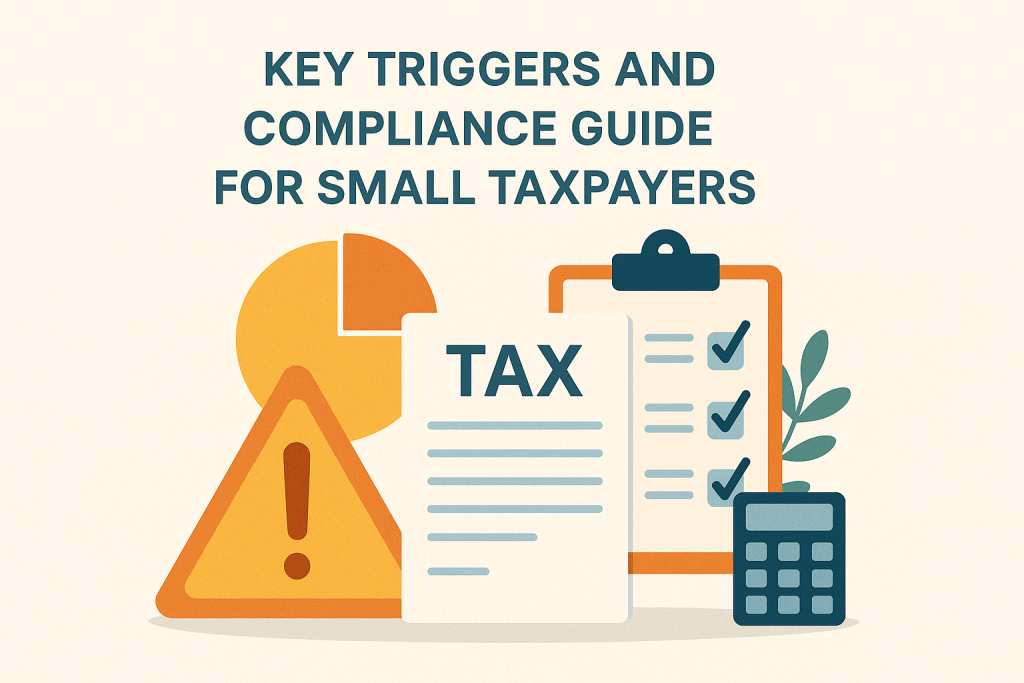Key Triggers and Compliance Guide for Small Taxpayers
Introduction
Tax Deducted at Source (TDS) has become a key compliance area for individuals and Hindu Undivided Families (HUFs), especially after the government expanded its scope through property purchases and large payments. Whether you’re buying a house, paying rent, or hiring contractors, it’s crucial to know when and how TDS needs to be deducted. This blog will simplify the key TDS triggers for small taxpayers and guide you through the compliance process.
Key TDS Scenarios for Individuals & HUFs
Here’s a quick overview of when TDS applies and at what rates:
Transaction Type | TDS Rate | Trigger Point | TAN Required? |
Buying a house (Sec 194IA) | 1% | Sale value > ₹50 lakh (per installment) | ❌ |
Paying rent to resident landlord (Sec 194IB) | 5% | Monthly rent > ₹50,000 (once a year) | ❌ |
Paying rent to NRI landlord (Sec 195) | 30% | Every month, regardless of amount | ✅ |
Buying property from NRI (Sec 195) | 12.5%* | On each payment | ✅ |
Contractual payments – audited entities (Sec 194C) | 2%** | ₹30,000 single or ₹1 lakh annual | ✅ |
Contractual payments – non-audited individuals (Sec 194M) | 5% | Once annual payment > ₹50 lakh | ❌ |
*12.5% applies if the house is a long-term asset (>2 years); 30% for short-term.
**2% if contractor is a company; 1% if individual.
Note: NRI payments also attract surcharge and cess.
Illustrative Examples
Example 1: Buying a House (Sec 194IA)
Mr. A buys a property worth ₹1 crore and pays ₹25 lakh every 6 months over 2 years.
✅ He must deduct 1% TDS (₹25,000) on each installment and deposit it using a challan-cum-statement.
❌ No TAN is required.
Example 2: Building a House (Sec 194M)
Mr. X hires a builder for ₹80 lakh and pays ₹20 lakh every quarter.
✅ Once total payments cross ₹50 lakh, he must deduct 5% TDS on the remaining ₹30 lakh (i.e., ₹1.5 lakh each quarter).
❌ No TAN is required.
TDS Compliance Process
Here are the steps you must follow to stay compliant:
- Get a TAN (Tax Deduction and Collection Account Number), if applicable.
- Deduct TDS at the time of payment.
- Deposit TDS by the 7th of the following month.
- For March payments, deposit by April 30.
- If TAN is not applicable, use a challan-cum-statement.
- e-TDS Return: Where TAN is applicable, file quarterly returns (Due: 31 July, 31 Oct, 31 Jan, 31 May).
- Issue Form 16 to the deductee within 15 days of filing the TDS return.
Penalties for Non-Compliance
TDS defaults can be expensive:
- Not Deducting TDS: Interest @ 1% per month.
- Deducted but Not Deposited: Interest @ 1.5% per month.
- Late Filing of TDS Returns: ₹200 per day (limited to TDS amount).
- Additional Penalties: Discretionary penalty under Sec 271C.
Important Note
For TDS scenarios where TAN is not required, the deductor must deposit TDS using a challan-cum-statement. There is no obligation to file a quarterly e-TDS return in such cases.
Conclusion
With increasing scrutiny on high-value transactions, small taxpayers can no longer afford to overlook TDS obligations. Whether you’re buying property, paying rent, or hiring professionals, understanding these triggers and following timely compliance will help you avoid penalties and ensure peace of mind.




